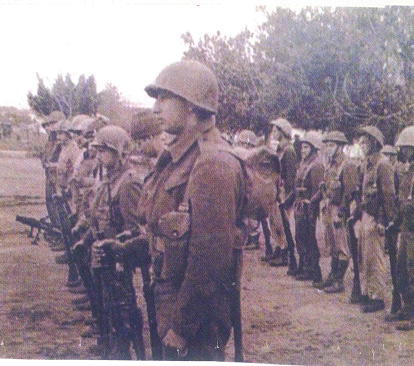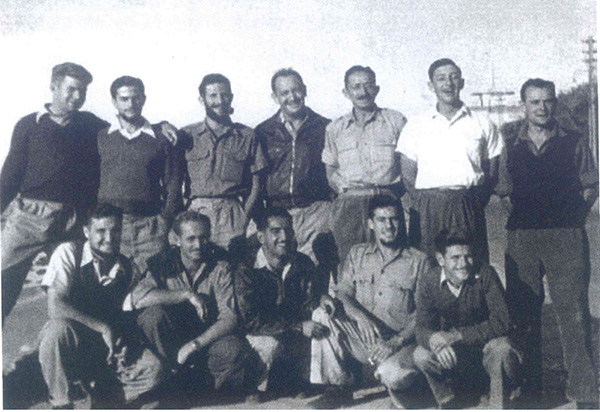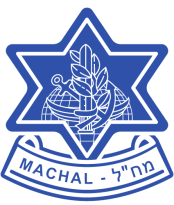
Harry Klass (right front row wearing World War II American steel helmet)
Harry was born in Cape Town to a Lithuanian-born father and a South African raised mother. Before he left for Israel in 1948, he had spent most of his life in the Transvaal town of Krugersdrop, about 30 kilometers west of Johannesburg.
At age 21 he volunteered to join the Israel Defense Forces with 830 other South Africans to defend the new-born state in its War of Independence. He joined the 72nd Infantry Battalion of the 7th Armored Brigade, serving in its completely English-speaking volunteer “B” Company. He proved to be an excellent “Spandau” light machine gunner in his squad. He fought alongside fellow South Africans in his battalion. The 7th was being re-organized in the North after having suffered many casualties in the earlier unsuccessful battles of Latrun.
In one memorable moment, he and his friends carried their wounded fellow South African Louis Hack , who had been struck by a single stray bullet that suddenly pierced the night. The platoon was returning from a raid on an Arab Liberation Army (ALA) headquarters deep within enemy territory. Having no stretchers at the time, South African medic “Locky” Fainman improvised a makeshift one, using rifles and battle-dress jackets. With some distance to get to Kibbutz Eilon, the platoon increased its pace. Waiting there was the battalion medical officer Dr. Harry Bank, in an ambulance driven by South African Simon Stern. Sadly, Louis died before they reached the hospital in Nahariya.

Guests at Lou Mazerow’s wedding on 16th November 1948. Harry Klass back row, second from right. (All except two in this photograph were from Krugersdorp)
After returning to South Africa, Harry remained a staunch member of the Machal association. Every year he attended the Independence Day lunch at the Israeli Embassy in Pretoria.
Harry was a brave man. For a young Jew to willingly volunteer and put his life in danger for the sake of his people was indeed heroic. He was one of a few thousand such heroes who came to Israel from all over the world to fight for the fledgling Jewish State then under attack from the Arab nations surrounding it on all sides.
During a visit to Israel in June 2015 he was able to visit Louis Hack’s grave in the military section of the Nahariya cemetery. He also managed to visit the tomb and shrine of Shimon Bar Yochai at Merom in the Eastern Galilee. Harry’s company had liberated it during the Hiram Operation on 29th October 1948. Rabbi Shimon was one of the leaders of the revolt against the Romans in AD135.
Harry died in Johannesburg in October 2015, a few months after his visit to Israel.
Sources:
1. Jewish Life magazine (Rabbi Yossi Goldman), October 2015
2. Joe Woolf, Chief Researcher, World Machal (and also served in the same platoon as Harry) and they had been close friends since 1948. Joe accompanied and drove him during his 2015 visits to the above-mentioned sites.

